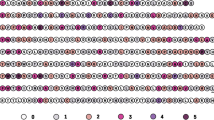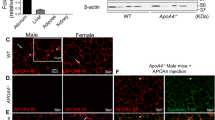Abstract
The defective binding of apolipoprotein (apo) E2 to lipoprotein receptors, an underlying cause of type III hyperlipoproteinemia, results from replacement of Arg 158 with Cys, disrupting the naturally occurring salt bridge between Asp 154 and Arg 158. A new bond between Asp 154 and Arg 150 is formed, shifting Arg 150 out of the receptor binding region. Elimination of the 154–150 salt bridge by site-directed mutagenesis of Asp 154 to Ala restored the receptor binding activity to near normal levels. The X-ray crystal structure of apoE2 Ala 154 demonstrated that Arg 150 was relocated within the receptor binding region. Our results demonstrate that defective binding of apoE2 occurs by a novel mechanism of the replacement of one salt bridge with another.
This is a preview of subscription content, access via your institution
Access options
Subscribe to this journal
Receive 12 print issues and online access
$189.00 per year
only $15.75 per issue
Buy this article
- Purchase on Springer Link
- Instant access to full article PDF
Prices may be subject to local taxes which are calculated during checkout
Similar content being viewed by others
References
Mahley, R.W. Apolipoprotein E: Cholesterol transport protein with expanding role in cell biology. Science 240, 622–630 (1988).
Weisgraber, K.H. Apolipoprotein E: Structure-function relationships. Adv. Prot. Chem. 45, 249–302 (1994).
Weisgraber, K.H., Rail, S.C., Jr. & Mahley, R.W. Human E apoprotein heterogeneity. Cysteine arginine interchanges in the amino acid sequence of the apo-E isoforms. J. Biol. Chem. 256, 9077–9083 (1981).
Weisgraber, K.H., Innerarity, T.L. & Mahley, R.W. Abnormal lipoprotein receptor-binding activity of the human E apoprotein due to cysteine arginine interchange at a single site. J. Biol. Chem. 257, 2518–2521 (1982).
Mahley, R.W. & Rail, S.C., Jr. in The Metabolic and Molecular Bases of Inherited Disease 7th ed (eds. Scriver, C.R., Beaudet, A.L., Sly, W.S. & Valle, D.) 1953–1980 (McGraw-Hill, New York, 1995).
Innerarity, T.L., Friedlander, E.J., Rail, S.C., Jr., Weisgraber, K.H. & Mahley, R.W. The receptor-binding domain of human apolipoprotein E. Binding of apolipoprotein E fragments. J. Biol. Chem. 258, 12341–12347 (1983).
Lalazar, A. et al. Site-specific mutagenesis of human apolipoprotein E. Receptor binding activity of variants with single amino acid substitutions. J. Biol. Chem. 263, 3542–3545 (1988).
Weisgraber, K.H. et al. The receptor-binding domain of human apolipoprotein E. Monoclonal antibody inhibition of binding. J. Biol. Chem. 258, 12348–12354 (1983).
Innerarity, T.L., Weisgraber, K.H., Arnold, K.S., Rail, S.C., Jr. & Mahley, R.W. Normalization of receptor binding of apolipoprotein E2. Evidence for modulation of the binding site conformation. J. Biol. Chem. 259, 7261–7267 (1984).
Wilson, C. et al. Salt bridge relay triggers defective LDL receptor binding by a mutant apolipoprotein. Structure 2, 713–718 (1994).
Wilson, C., Wardell, M.R., Weisgraber, K.H., Mahley, R.W. & Agard, D.A. Three-dimensional structure of the LDL receptor-binding domain of human apolipoprotein E. Science 252, 1817–1822 (1991).
Goobar-Larsson, L. et al. Disruption of a salt bridge between Asp 488 and Lys 465 in HIV-1 reverse transcriptase alters its proteolytic processing and polymerase activity. Virology 196, 731–738 (1993).
Evans, R.W. et al. Characterization and structural analysis of a functional human serum transferrin variant and implications for receptor recognition. Biochemistry 33, 12512–12520 (1994).
Rao, V.R., Cohen, G.B. & Oprian, D.D. Rhodopsin mutation G90D and a molecular mechanism for congenital night blindness. Nature 367, 639–642 (1994).
Innerarity, T.L., Hui, D.Y., Bersot, T.P. & Mahley, R.W. Type III hyperlipoproteinemia: A focus on lipoprotein receptor-apolipoprotein E2 interactions. Adv. Exp. Med. Biol. 201, 273–288 (1986).
Smith, D.B. & Johnson, K.S. Single-step purification of polypeptides expressed in Escherichia coli as fusions with glutathione S-transferase. Gene 67, 31–40 (1988).
Dong, L.-M. et al. Human apolipoprotein E. Role of arginine 61 in mediating the lipoprotein preferences of the E3 and E4 isoforms. J. Biol. Chem. 269, 22358–22365 (1994).
Studier, F.W. & Moffatt, B.A. Use of bacteriophage T7 RNA polymerase to direct selective high-level expression of cloned genes. J. Mol. Biol. 189, 113–130 (1986).
Engh, R.A. & Huber, R. Accurate bond and angle parameters for X-ray protein structure refinement. Acta Crystallogr. A47, 392–400 (1991).
Sheldrick, G.M. SHEXL-93 crystal structure refinement program. (1993).
Brünger, A.T. X-PLOR, Version 3.1. A System for X-ray Crystallography and NMR. (Yale University Press, New Haven, 1992).
McRee, D.E. Practical Protein Crystallography. (Academic Press, San Diego, 1993).
Brünger, A.T. Free R value: A novel statistical quantity for assessing the accuracy of crystal structures. Nature 355, 472–475 (1992).
Somoza, J.R. et al. Holographic methods in X-ray crystallography. IV. A fast algorithm and its application to macromolecular crystallography. Acta Crystallogr. A51, 691–708 (1995).
Parkin, S., Moezzi, B. & Hope, H. XABS2: An empirical absorption correction program. J. Appl. Crystallogr. 28, 53–56 (1995).
Laskowski, R.A., MacArthur, M.W., Moss, D.S. & Thornton, J.M. PROCHECK: A program to check the stereochemical quality of protein structures. J. Appl. Crystallogr. 26, 283–291 (1993).
Rall, S.C., Jr., Weisgraber, K.H. & Mahley, R.W. Isolation and characterization of apolipoprotein E. Methods Enzymol. 128, 273–287 (1986).
Innerarity, T.L., Mahley, R.W., Weisgraber, K.H. & Bersot, T.P. Apoprotein (E-A-II) complex of human plasma lipoproteins. II. Receptor binding activity of a high density lipoprotein subfraction modulated by the apo(E-A-ll) complex. J. Biol. Chem. 253, 6289–6295 (1978).
Bilheimer, D.W., Eisenberg, S. & Levy, R.I. The metabolism of very low density lipoprotein proteins. I. Preliminary in vitro and in vivo observations. Biochim. Biophys. Acta 260, 212–221 (1972).
Innerarity, T.L., Pitas, R.E. & Mahley, R.W. Binding of Arg rich (E) apoprotein after recombination with phospholipid vesicles to the low density lipoprotein receptors of fibroblasts. J. Biol. Chem. 254, 4186–4190 (1979).
Author information
Authors and Affiliations
Rights and permissions
About this article
Cite this article
Dong, LM., Parkin, S., Trakhanov, S. et al. Novel mechanism for defective receptor binding of apolipoprotein E2 in type III hyperlipoproteinemia. Nat Struct Mol Biol 3, 718–722 (1996). https://doi.org/10.1038/nsb0896-718
Received:
Accepted:
Issue Date:
DOI: https://doi.org/10.1038/nsb0896-718
This article is cited by
-
Association of APOE genotype with lipid profiles and type 2 diabetes mellitus in a Korean population
Genes & Genomics (2021)
-
ε2 allele and ε2-involved genotypes (ε2/ε2, ε2/ε3, and ε2/ε4) may confer the association of APOE genetic polymorphism with risks of nephropathy in type 2 diabetes: a meta-analysis
Lipids in Health and Disease (2020)
-
Apolipoprotein E and Alzheimer disease: pathobiology and targeting strategies
Nature Reviews Neurology (2019)
-
Polymorphism and plasma levels of apolipoprotein E and the risk of aneurysmal subarachnoid hemorrhage in a Chinese population: a case-control study
Lipids in Health and Disease (2018)
-
Apolipoprotein E polymorphism and the risk of aneurysmal subarachnoid hemorrhage in a South Indian population
Cellular & Molecular Biology Letters (2017)



